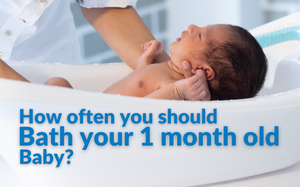Parents often wonder when the right potty training age for kids is. While most children are ready for it between the ages of 18 and 24 months, some may take longer. Girls generally start earlier and take less time to be trained than boys. The key is patience, because each child is unique, and different strategies work for different toddlers.
When should I start potty training my child?
It is necessary to watch your child for signs of readiness, such as:- Keeping a diaper dry for more than two hours.
- Walking well and sitting down.
- Imitating the behaviour of other family members.
- Showing an interest in doing some things by themselves.
- Following simple instructions.
- Being able to try to pull down diapers or underpants.
How to start potty training?
Potty training is a slow process that may take several days to several months. Night-time dryness may take even longer. Before you start your training, prepare your kids by:- Make use of simple words like "pee" and "poop" when teaching them how to use the potty.
- Help your child feel comfortable telling you when the diaper is dirty or wet.
- Teach your child to recognise the signs of having to pee or poop ("Is a poop coming?").
- Allow your child to practise sitting on a potty chair with clothes or a diaper on.
When to start potty training?
Here are ways to know if your little one is ready for the actual training::- Explain how a toilet works and how to use one.
- Children typically feel the need to use the restroom shortly after eating, so encourage them to use the potty within half an hour. If your child has a regular time for bowel movements, let them sit on the potty at that time and at regular intervals during the day. However, don’t force them to sit against their will.
- Take your child to the potty if they show signs of needing to use the toilet, such as crossing legs, squatting, or grunting.
- Empty the diaper contents into the toilet in front of them to show them where it goes.
- Teach them to take off their pants to use the potty independently.
- Make sure your child’s caregivers follow the same method you use for potty training.
- Praise your child for all their efforts during training. Do not express disappointment if they wet or soil themselves. You can also reward your child by giving them a sticker when they recognise they want to go potty or successfully pee or poo in the potty.
- Make your child comfortable while they use the potty by reading or talking to them.
- Give them clothes that are easy to take off, e.g., pull-up pants or underwear.
- Boys should learn to urinate while seated before progressing to standing. Teach them to shake their penises after they urinate to get rid of any remaining urine.
- Wipe their bottoms until they can do it themselves. Girls should be taught to wipe from the front to the back.
- Teach your baby to wash their hands properly after using the potty.
What equipment should I use for potty training my child?
To train a child to use the restroom independently, you can use a potty seat, a chair, or a child-sized toilet seat that fits on a standard toilet. Some children are afraid of the adult toilet and may learn better with a potty chair, while some children adapt quite well to the kid’s toilet seat as they see the adults in their home using it.Each of these potty training methods has its own pros and cons, as below:
1. A potty
It is a standalone plastic chair custom-made for kids.
Pros:
- A potty can be moved to any room, or you can place one in every room. It is especially handy during the first few days of potty training when your kid is still learning to hold the pee or potty for a few precious seconds until they reach the seat!
- It's easy for kids to get on and off, so they can be more independent.
- You can personalise it with stickers or decals.
- Easy to carry while traveling.
- Colourful and small, making it less daunting for kids.
Cons:
- Dumping the contents and cleaning.
- It is not made for boys to pee standing up, as it can cause splashing.
- Kids can fall off if not properly supported.
2. A kid-size toilet seat
This is a small seat that can be attached to the adult toilet.
Pros:
- There is nothing to dump or clean out as the contents go directly into the toilet.
- Colourful, portable, lightweight, and easy to carry while traveling.
- A stepping stool used with this seat allows the child to rest their legs or push against it while pooping.
- Using a potty training seat makes the transition to the adult toilet easy.
Cons:
- Cannot be used in rooms other than the bathroom.
- Needs a stepping stool for the child to reach the toilet.
- Removing it before use can be a hassle for adult family members if they share a bathroom.
- As it can only be placed in the toilet, it may be hard for the child to reach the seat on time.
Remember, there is no specific potty training age. It needs to start when your child is ready.
Starting potty training too early can make the process longer and more frustrating, and starting it too late can make it harder for kids to learn to use the potty. However, at no age should kids feel pressured to use the potty, as it may lead to problems like constipation.
If the training is not progressing, wait for a few days or weeks and then try again. Sometimes, stress or major changes in life, such as having a new sibling or moving to a new house, may affect your child’s potty-training progress.
Ask your paediatrician for advice if your child is four years or older and not potty trained yet, or if he/she was potty trained but has started having accidents.
The BabyG App has more information like this—for everything baby related, alongside articles specifically designed for parents to stay informed and on top of their baby's developmental needs.
References
- NCBI. Potty training: Overview [2021].
- Gavin ML. When are kids ready to toilet train? [2021].
- NCBI. Helping your child with potty training [2021].
- Raising Children Network. Toilet training: a practical guide [2021].













LEAVE A COMMENT